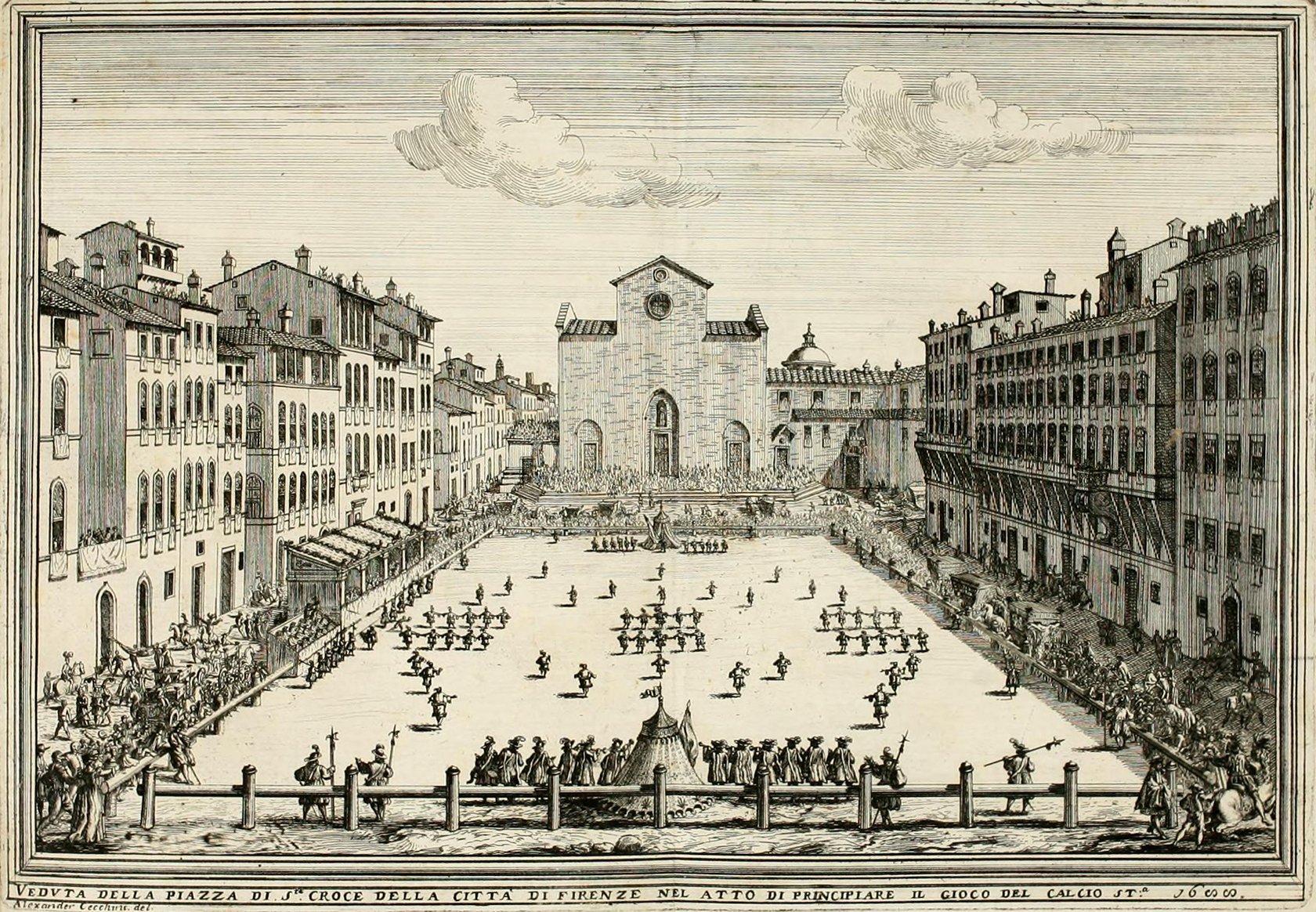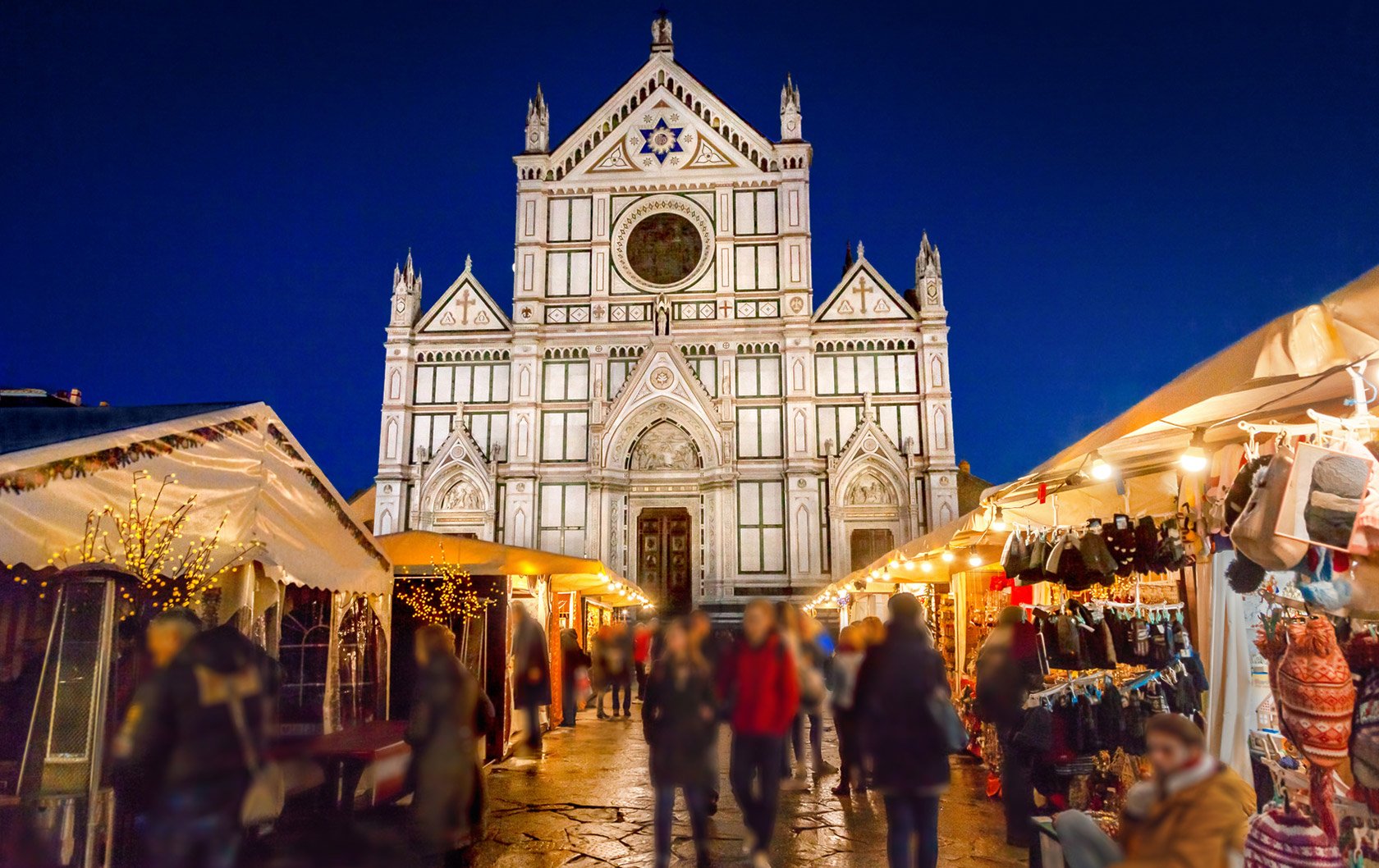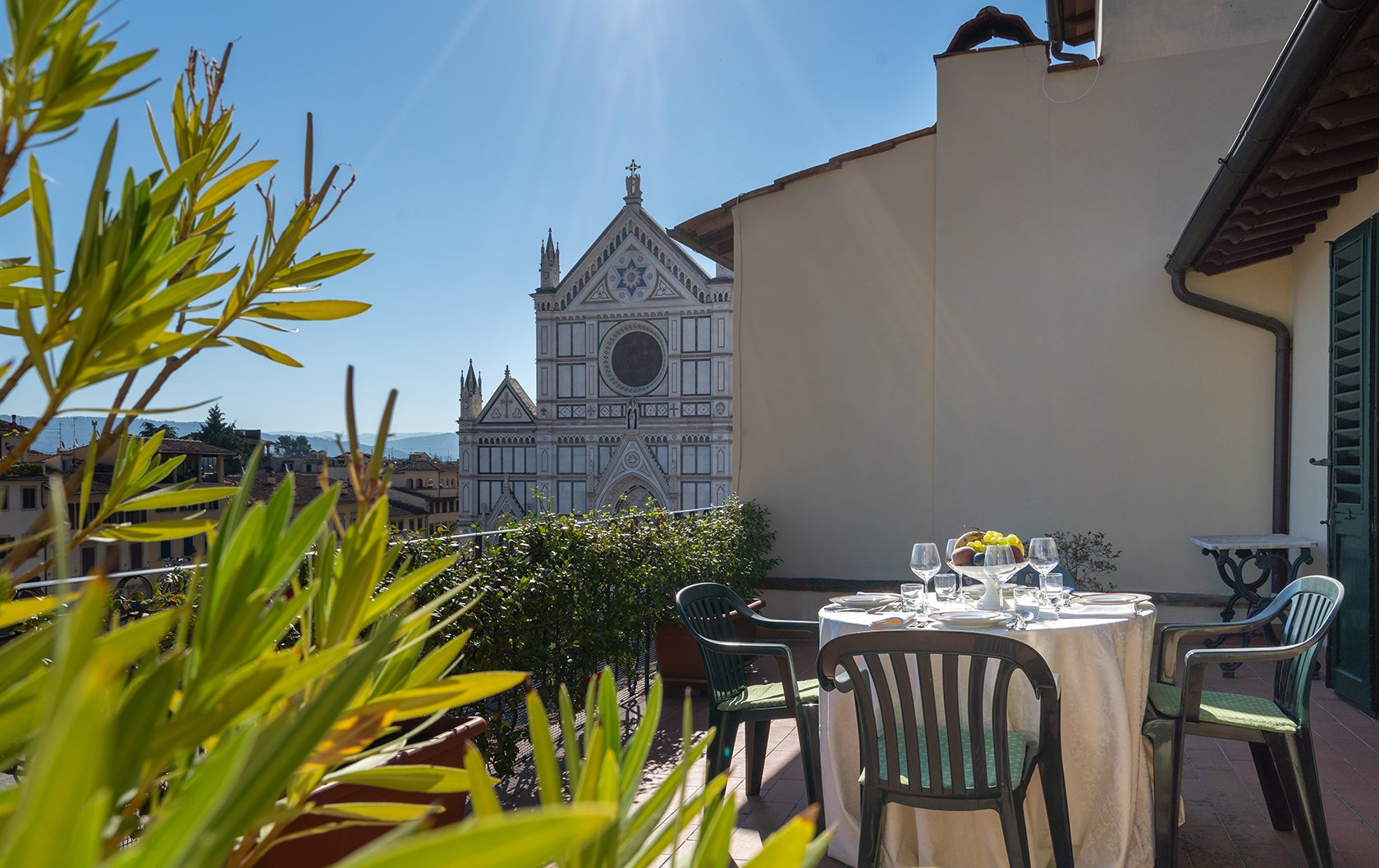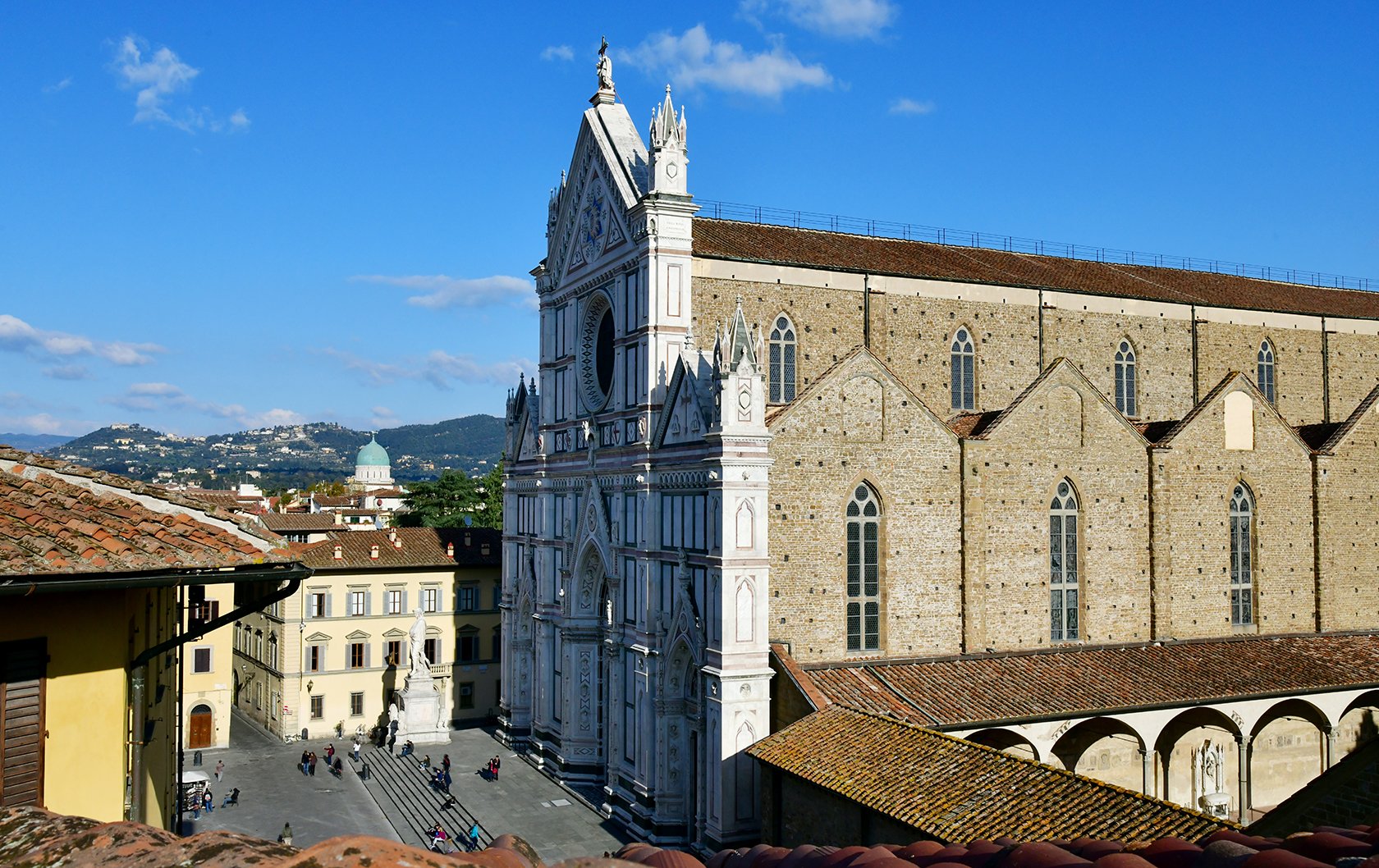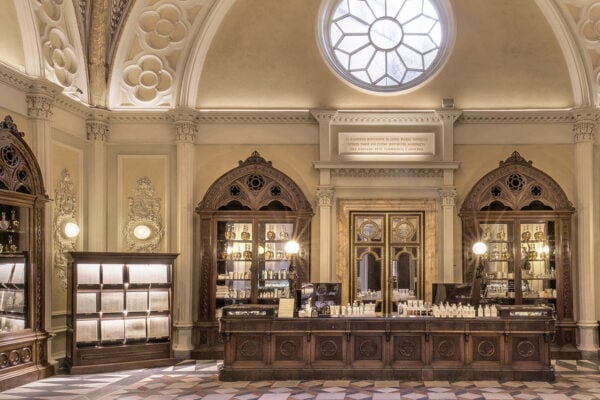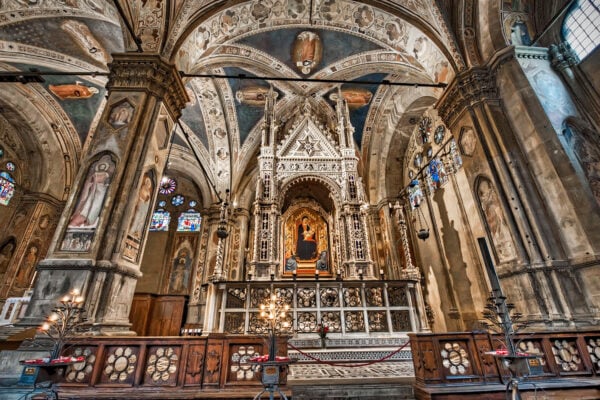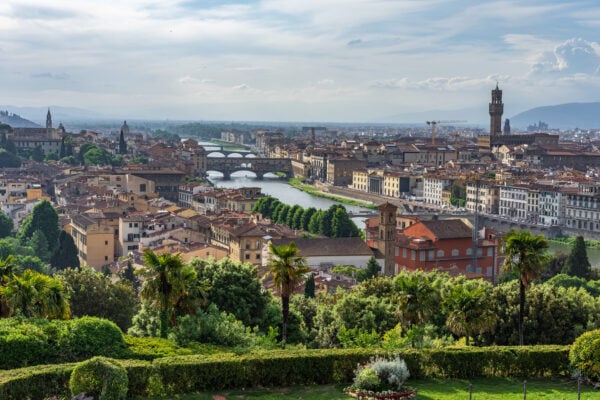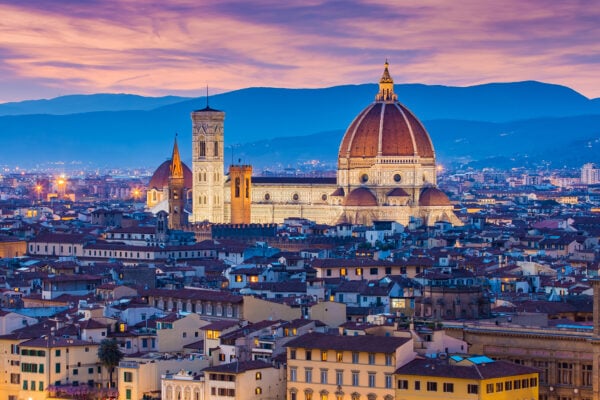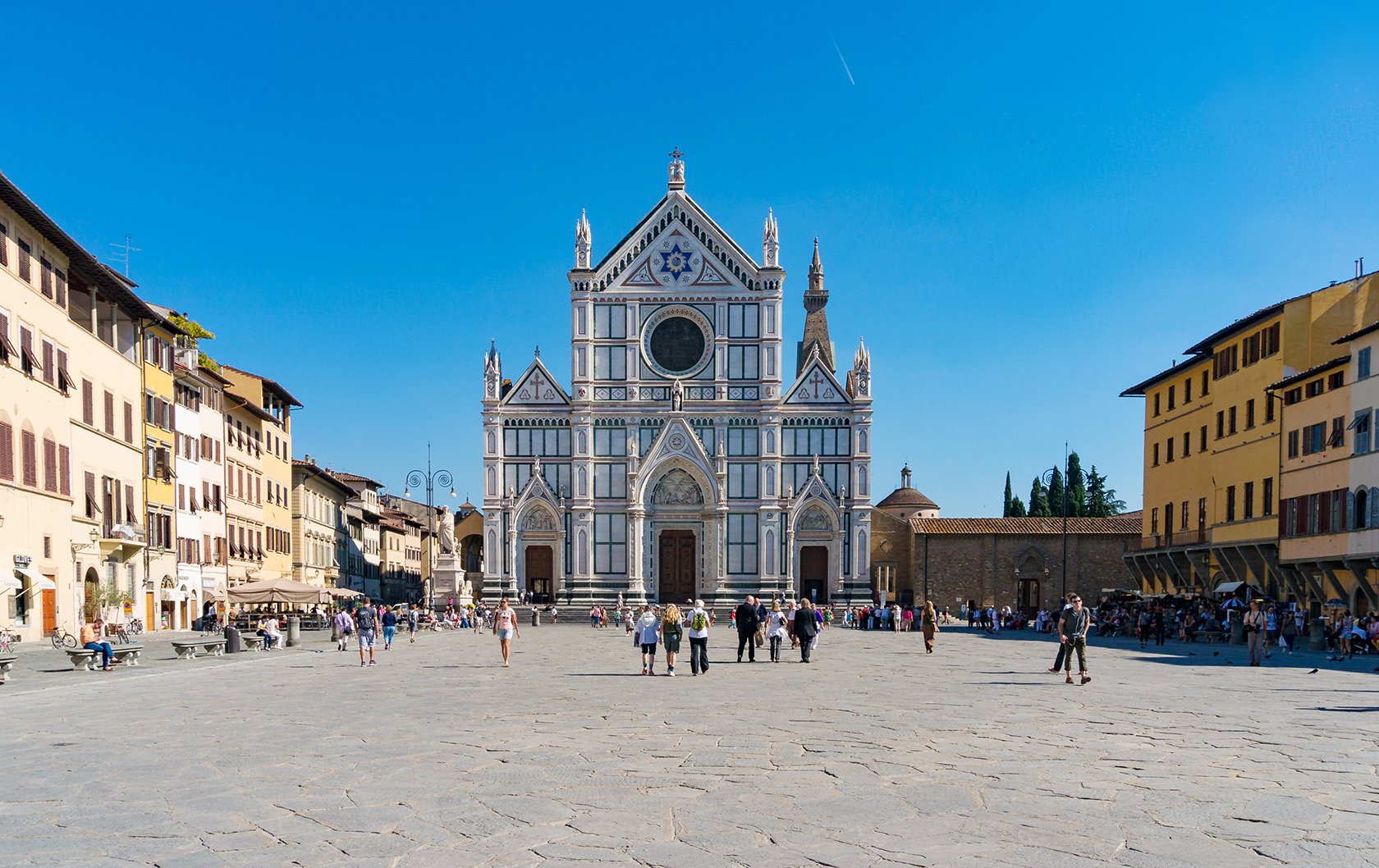
Florence is a city of beautiful squares, from the buzz of Piazza del Duomo to sweeping views from Piazzale Michelangelo and the grace of Piazza Santa Croce. A crossroads of history, culture and faith, Piazza Santa Croce is one of the most captivating squares in Florence. Surrounded by historic buildings and home to the remarkable Basilica of Santa Croce, it’s a perfectly romantic spot to sit and admire the church, take a closer look at artistic details, like the 17th-century frescoes decorating the Palazzo dell’Antella, or simply soak up the Tuscan sun with some fine people watching. Come along on a journey as we explore the history of this beautiful piazza and share our favorite things to see and do while in Santa Croce.
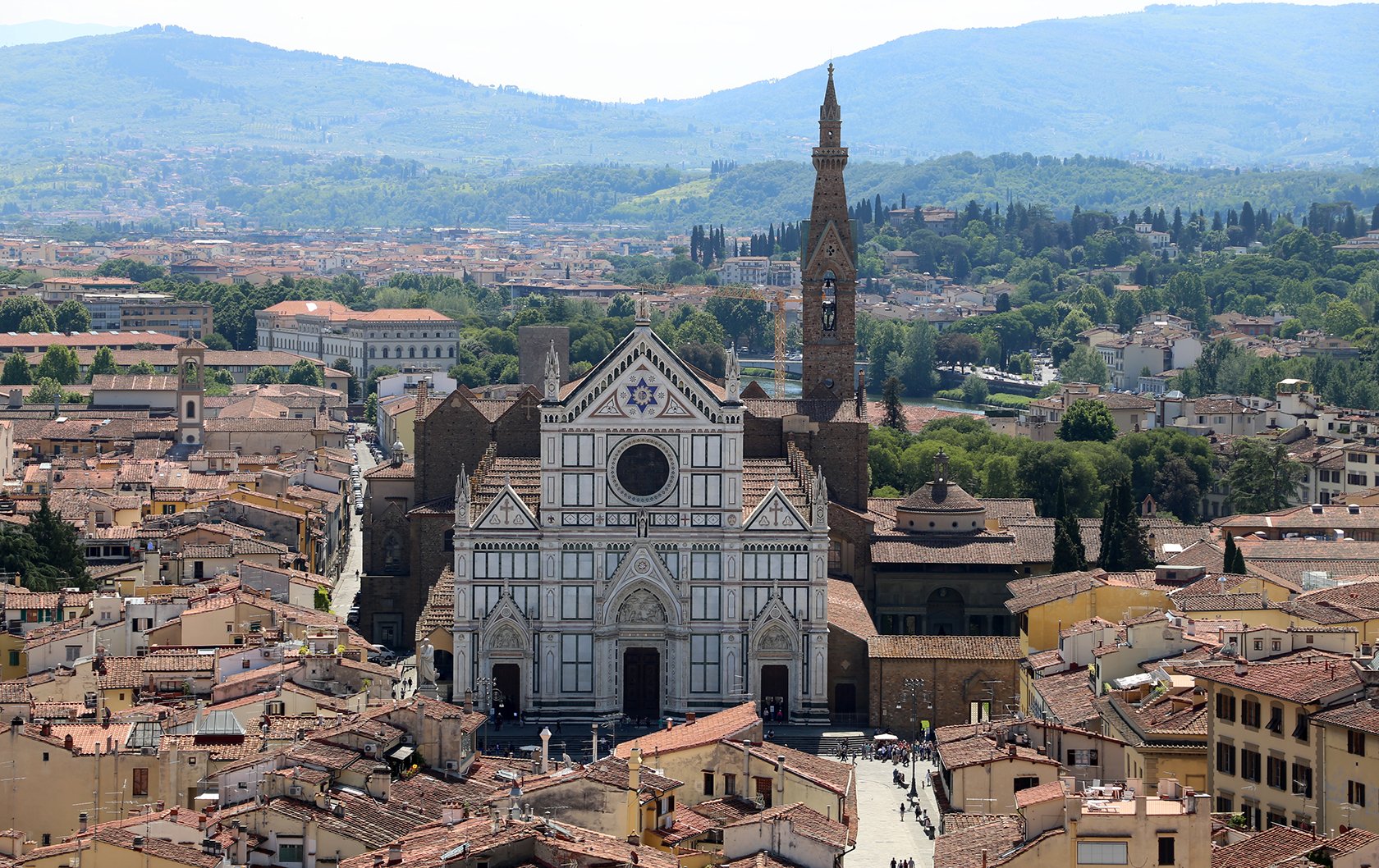
The Basilica of Santa Croce (Credit)
From Island to Grand Piazza
Although it seems unlikely today, the Santa Croce area was originally an island formed by two branches of the Arno river. When the Franciscans arrived in Florence in the early 13th century, they chose this isolated and marshy area outside the city walls to found a church. The sparsely populated area made it possible to create a large space to welcome the many faithful who would gather to hear the sermons. And so, Piazza Santa Croce was born. In the 14th and 15th centuries, the large size and rectangular shape of the piazza made it a popular spot for festivals, jousting, and city celebrations as well as religious celebrations connected to the church.
The piazza is now surrounded on three sides by historic buildings, many dating from the 15th and 16th centuries. The varied architectural styles and warm Tuscan hues only adds to the charm of the piazza. In front of the basilica, just to the left of the facade, stands an impressive monument celebrating Dante Alighieri. The large statue of Italy’s beloved poet was placed in the center of the piazza in 1865 on the 600th anniversary of his birth. It was later moved to its current location for the revival of Calcio Storico, a wildly fun game that we’ll return to soon.
Before going into the basilica, stop on the north side of the piazza not far from the statue of Dante and look up on the buildings for the plaque marking the high point of the disastrous and deadly flood of 1966. It’s a reminder that the Arno isn’t very far away at all.
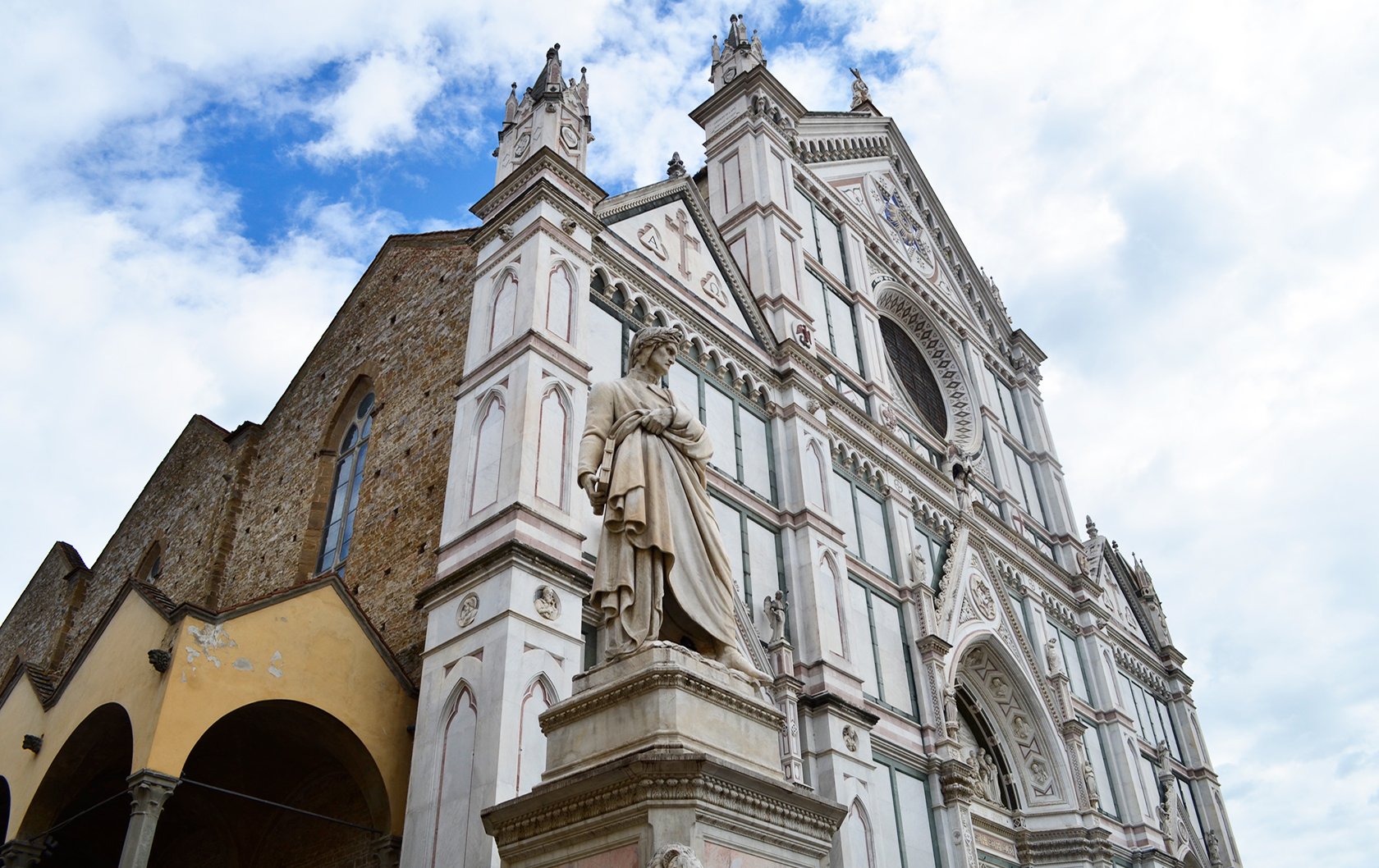
Statue of Dante in Piazza Santa Croce (Credit)
Basilica of Santa Croce
Overlooking the piazza is the church that gives the square its name: the Basilica of Santa Croce. In 1933, Pope Pius XI recognized Santa Croce as a basilica, which is a title of honor for churches of historic and religious importance. Santa Croce certainly checks both those boxes! It is the largest Franciscan church in the world, one of Italy’s artistic treasures and serves as a pantheon of many of Italy’s most illustrious people. A visit inside makes one understand firsthand the idea of Stendhal Syndrome, also called Florence Syndrome, when the intensity of art becomes a swirling experience that overwhelms. In was right in the Basilica of Santa Croce in 1817 that the French writer Stendhal had the heart racing, dizzying experience. But, don’t worry, while a visit to Santa Croce is quite an experience, it’s an overwhelmingly beautiful one.
The first glimpse you’ll likely have of Santa Croce is the striking facade. While the church itself was founded in the 13th century, quite possibly by St. Francis himself, the ornate facade we see today is a 19th-century Gothic Revival design by the architect Niccolò Matas. It was built from 1857-1863, with the finishing touches complete in 1865 so as to be timed with the placement of the statue of Dante. If you’re thinking it’s a bit strange that the church didn’t have a finished facade for over 500 years, it turns out that it wasn’t an uncommon occurrence. Before the 19th century, Santa Croce had an unfinished stone facade much like the Basilica of San Lorenzo in Florence that lacks a facade even today. The impressive facade of Florence’s Duomo was also a 19th century addition. In an age of architectural revivalism, Matas’s design for Santa Croce was inspired by the great Gothic cathedrals in Siena and Orvieto. However, on Santa Croce’s facade you’ll notice a prominent Star of David at the top. There are a number of theories about the star design, but the 6-pointed star has been used in many religions including Christianity.
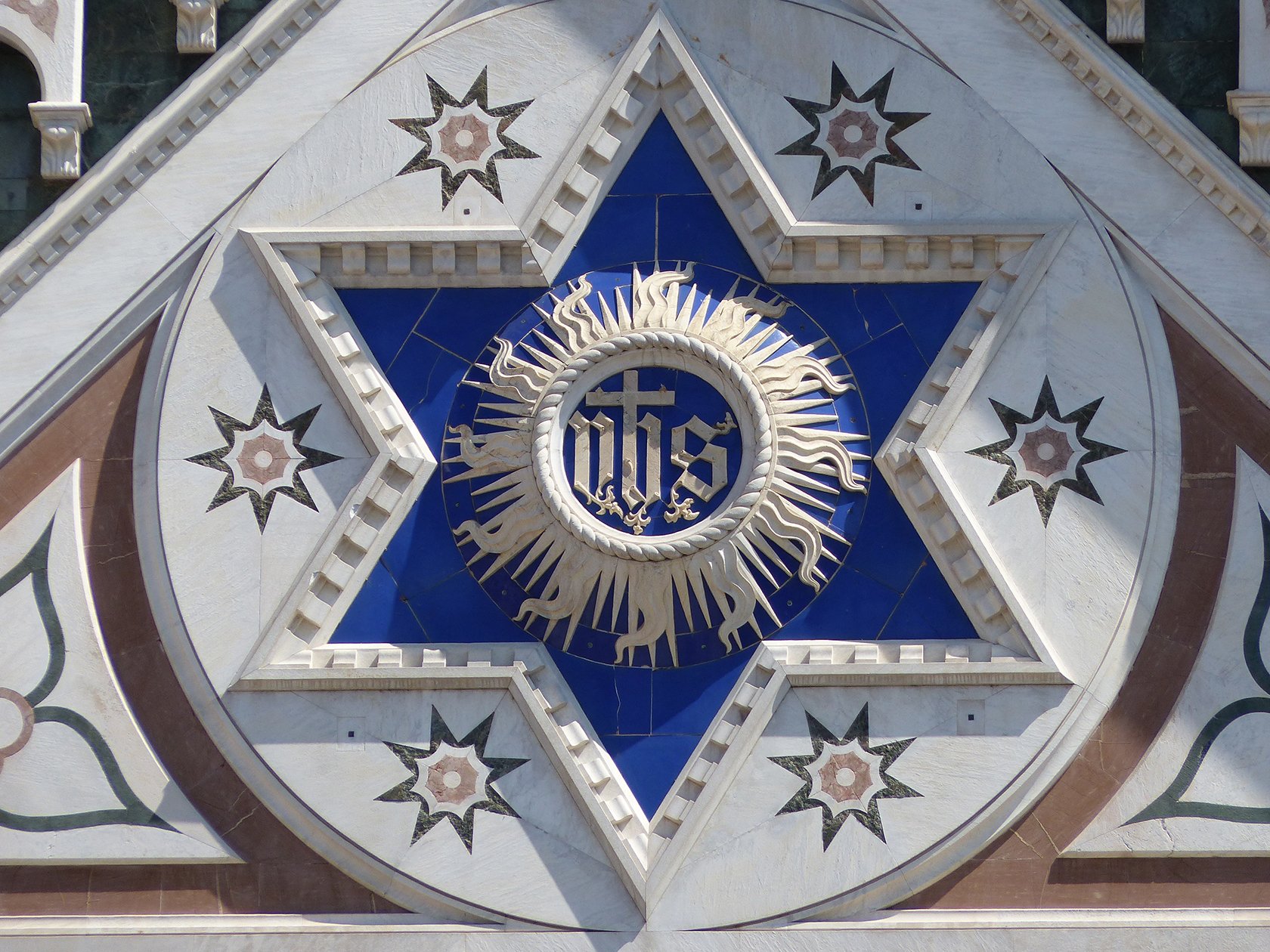
Detail of the Santa Croce facade (Credit)
Navigating the interior of the basilica is impressive in so many ways. It’s home to incredible frescoes by Giotto, artwork by Italian masters, tombs for the “gods” of Italy, its most important scientists, artists, writers and important figures, a peaceful cloister and the famous Pazzi Chapel, which is a serene example of high Renaissance architecture. Stepping inside the soaring nave, the sobriety of the Gothic design serves as a framework with large arches showcasing monuments and tombs lining each side of the nave. Among the “stars of Italy” memorialized with monuments are Galileo and Michelangelo, as well as Renaissance architect Leon Battista Alberti, Florentine artist Lorenzo Ghiberti, Niccolò Macchiavelli and Gioacchino Rossini.
The burials for Galileo and Michelangelo both have fascinating stories. Michelangelo’s body was stolen from his original burial place in Rome by his nephew to bring it to Florence. Because of his blasphemous scientific theories, Galileo was first buried in an inconspicuous place. When he was finally moved to a more formal tomb about 100 years later, they discovered two additional bodies with him! One was his pupil and curator and the other was believed to be his beloved daughter who had been separated from him for life because she was a cloistered nun and he was long under house arrest for the blasphemy of asserting that the earth revolved around the sun. Shockingly, this sentence of blasphemy wasn’t lifted until 1992! If you’re curious to find out more, the book Galileo’s Daughter: A Historical Memoir of Science, Faith, and Love by Dava Sobel is an excellent read.
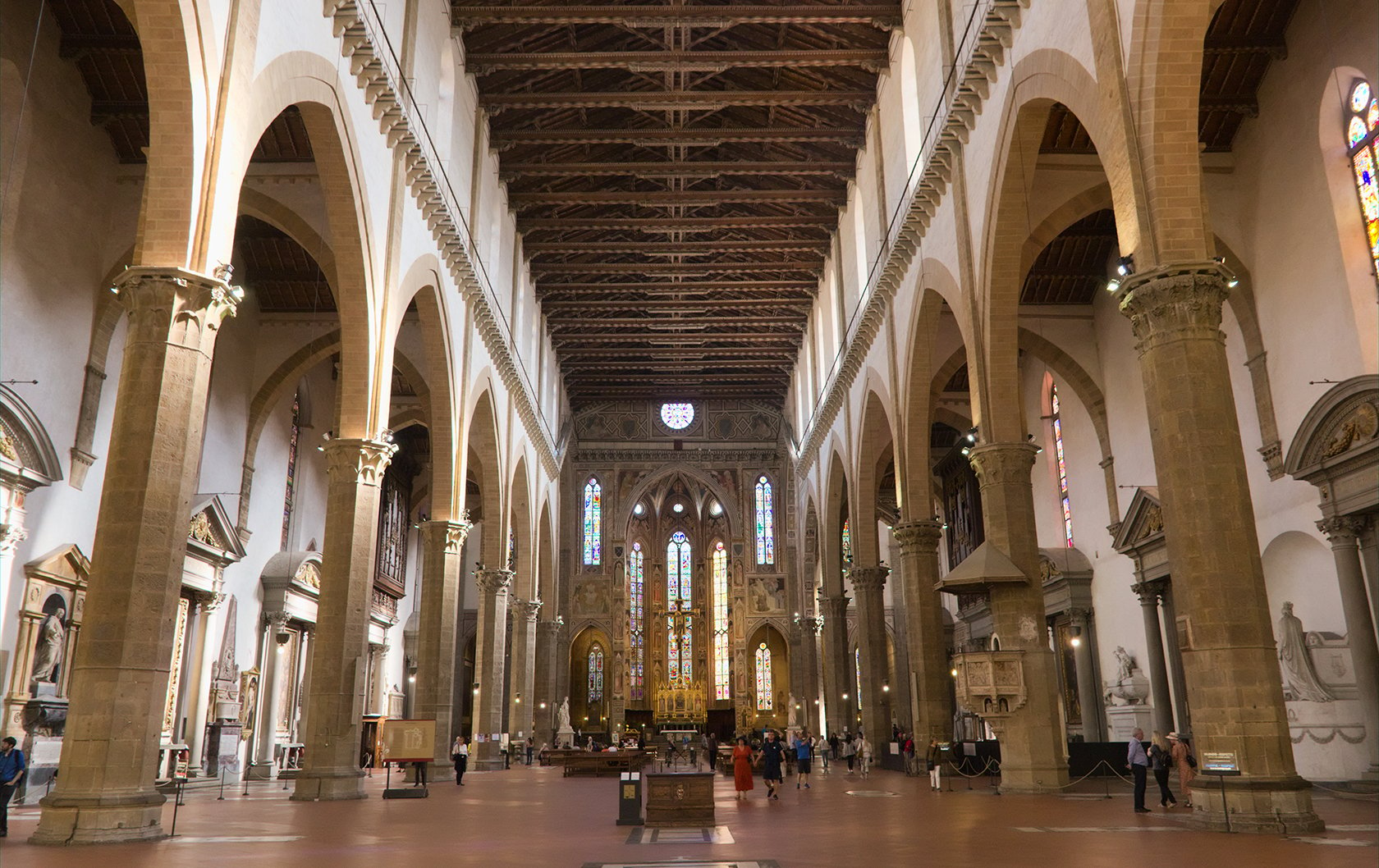
The soaring nave of Santa Croce (Credit)
In addition to the tombs and memorials, Santa Croce is a treasure trove of work by some of Italy’s most famous artists. Seeing the 14th-century frescoes by Giotto in person is certain to be a highlight. Often referred to as the father of European painting and one of the most influential artists of his time, Giotto’s frescoes in the Bardi and Peruzzi chapels of Santa Croce are incredible examples of his work that capture a moment in late Gothic art when elements of the Renaissance period to come were starting to appear. Unfortunately, the frescoes in both chapels were covered in quicklime in the 1700s and not uncovered again until the mid 19th century. Restoration work (with varying levels of success) has left the frescoes faint and damaged in places, yet this somehow adds to the experience – as if you’ve glimpsed something rare that was almost lost to time.
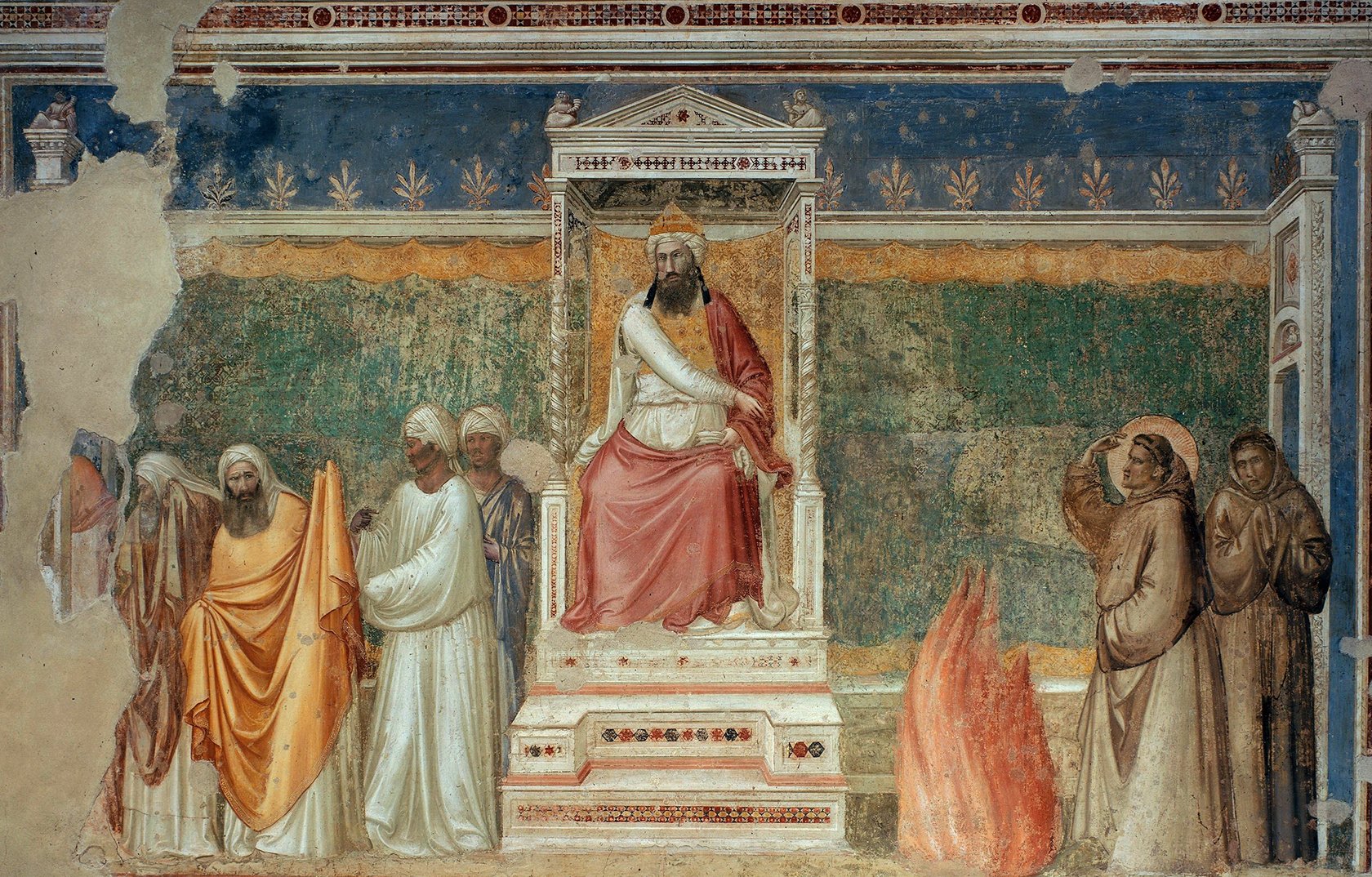
Giotto’s St. Francis before the Sultan (Trial by Fire) in the Bardi Chapel (Credit)
Don’t miss the 14th-century frescoes in the Baroncelli chapel by Taddeo Gaddi and the impressive fresco cycle around the main altar by Agnolo Gaddi, the son of Taddeo, depicting scenes from The Legend of the True Cross. Completed around 1380, they form a captivating backdrop, along with the stained glass windows, to the gilded altarpiece and the 14th-century cross attributed to Maestro di Figline. Every single nook of Santa Croce houses treasures to discover, so be sure to plan plenty of time to visit inside the church.
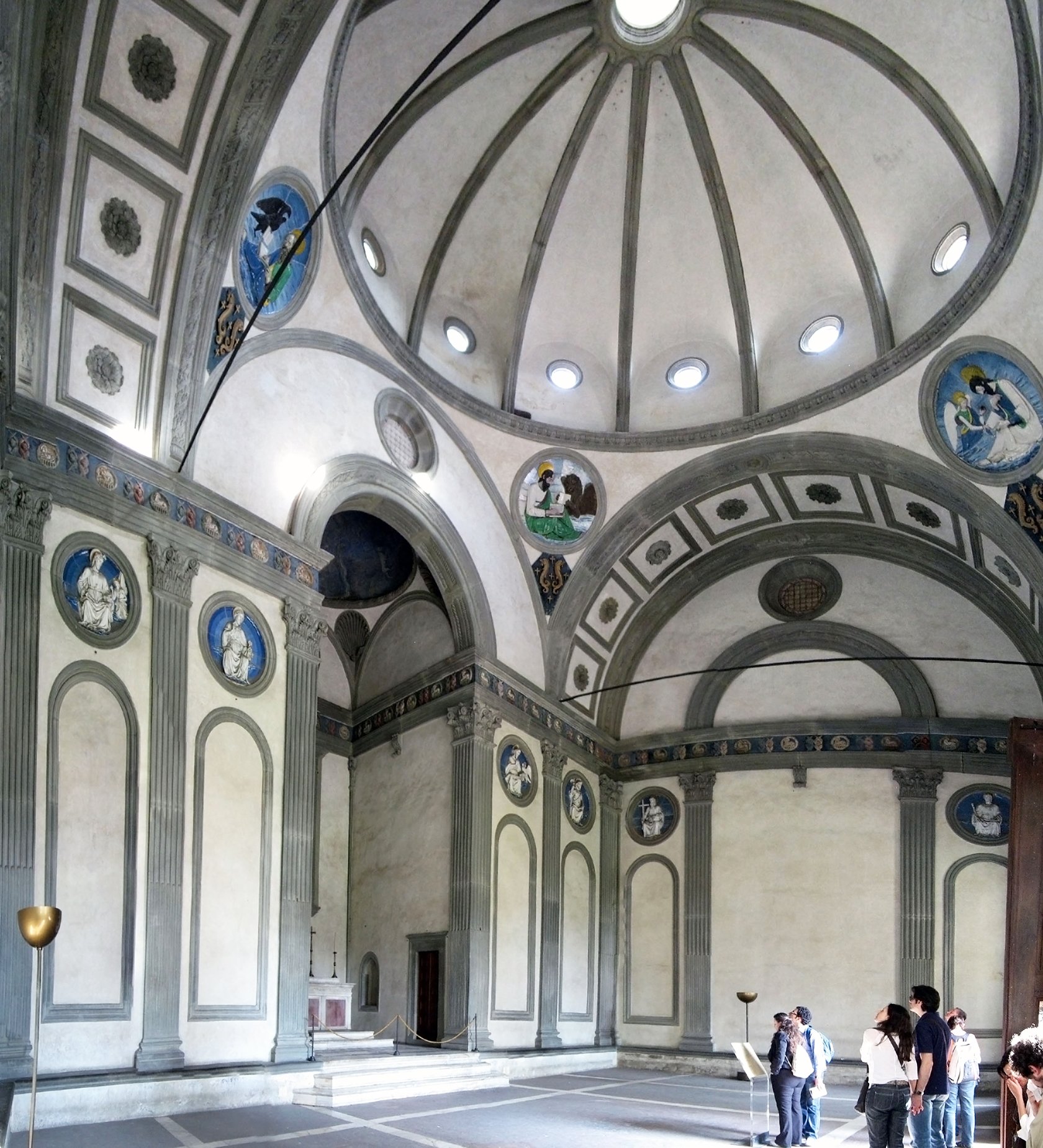
The sublime Pazzi Chapel
After exploring the nave of the basilica, head outside to visit the cloisters and experience the Pazzi Chapel designed by Renaissance master architect Brunelleschi. Although commissioned in 1429 for the project, work didn’t begin on the chapel until 1442 and wasn’t quite complete at the time of Brunelleschi’s death in 1446. The final form was never realized, largely due to the disputes between the Pazzi family and its rival the Medici family. However, the essence of the chapel’s design, with its harmonious balance and geometric forms based on circles and squares, heavily influenced architectural design to come. Spare and silent, the chapel invites meditation and a moment of calm.
From the first cloister, you can explore further in the basilica’s Museum of the Opera (Works) of Santa Croce and beyond that Brunelleschi’s cloister. Before leaving, don’t miss Cimabue’s 13th-century cross, Donatello’s gilded bronze statue of St. Louis of Toulouse made in the 15th century for the Orsanmichele church and many more incredible works of art on display in the museum.
A Calcio Storico game in Piazza Santa Croce from 1688 – notice the church without its 19th-century facade (Credit)
Calcio Storico
In June, Piazza Santa Croce is home to a uniquely Florentine sport experience. Calcio Storico, also called Calcio fiorentino, is a game that started in the 16th century. It’s considered a precursor to soccer as we know it today even if the game is more reminiscent of an intense rugby match. Soccer is called calcio in Italian, and the game that Italians adore seems to have started right here – in Piazza Santa Croce. While it may be centuries old, seeing the Calcio Storico today is an astounding experience. After a historical parade, buckle up for the game to begin. Don’t worry too much about the rules since there aren’t that many – and almost everything is allowed. Florence is divided into four quarters with a team of 27 men for each area. Somewhat like modern day gladiators, the players attack in all forms (martial arts are allowed) to score points by getting the ball through the goals at the ends of the field. No substitutions are allowed in the often brutal 50 minute game.
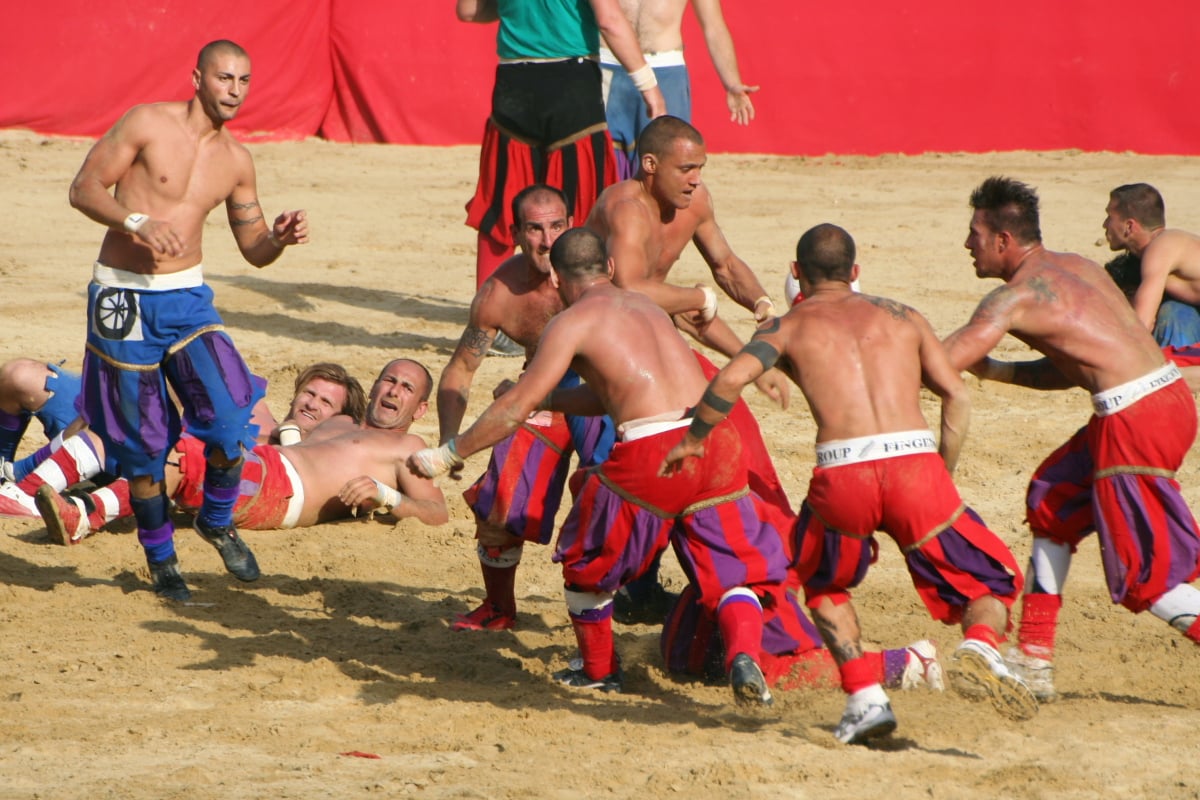
An intense Calcio Storico game (Credit)
To experience the Calcio Storico for yourself, plan to visit Florence in June. A playing field made of sand is created in Piazza Santa Croce and games begin with semifinals in early June. Locals scoop up the tickets to the bleachers for the final game, which takes place on June 24th, the festival day of St. John the Baptist, Florence’s patron saint. If you’re looking for a stellar view of the games, you’ll want to book one of our vacation rentals overlooking Piazza Santa Croce well in advance.
If you’re curious to find out more about Calcio Storico, the first episode of the series Home Game on Netflix is all about the history of the game today. We highly recommend it!
Events in Piazza Santa Croce
With such a scenic setting, events and concerts take place throughout the year in Piazza Santa Croce. Our guests are often thrilled to find they have a perfect view for performances by artists like Il Volo, Jethro Tull, Leonard Cohen as well as political and dramatic presentations and large scale art installations. For a small taste of the magical experience, enjoy this stunning performance by the young Italian operatic pop trio Il Volo performing Nessun Dorma in Piazza Santa Croce.
At the end of November the piazza is transformed into a festive Christmas market complete with wooden stalls selling gifts, food and more during the holiday season. It’s modeled after the German style Christmas markets and is complete with beer, pretzels and oompah music. You’ll find Italian crafts as well as products from around Europe. It’s a fun Italian Christmas experience with the beautifully lit up facade of Santa Croce creating an unforgettable backdrop.
Dining & Shopping in Santa Croce
From tiny trattorias to local haunts and excellent cafés, tempting choices abound in the Santa Croce neighborhood. If you’re staying in an Italy Perfect apartment rental in Florence, or just enjoy a good market, you’ll want to explore the Sant’Ambrogio market nearby at Piazza Lorenzo Ghiberti. It’s hard to miss as it’s located in a 19th-century iron and glass market building designed by the architect Giuseppe Mengoni, famous for the Galleria Vittorio Emanuele II shopping arcade in Milan. The market takes places daily Monday to Saturday from 7am-2pm and has stalls both inside the market building and outside surrounding it on three sides. You’ll find everything you need for cooking, from fruit and vegetables, meat, fish, cheese, and fresh bread to stalls selling flowers, vintage clothes, and the classic leather goods.
Start your day in Santa Croce by stopping in at Finisterrae at the corner of Piazza Santa Croce (near the statue of Dante) for something sweet. This restaurant and pizzeria is also a great pasticceria and they make what seems like 20 flavors of fresh cornetti (croissants) every morning along with tempting pastries. For another excellent spot right on Piazza Santa Croce, head to Boccadama located in a historic building on the piazza. Grab a spot at one of the outdoor tables or enjoy a meal in the cozy dining area lined with wine bottles. The menu has Tuscan classics like Pappardelle al cinghiale, thick pasta noodles with wild board, and, of course, the traditional bistecca alla fiorentina.
After one visit, you’ll find yourself going back again and again to Vivoli to keep sampling their delicious and innovative gelato flavors. Known around the world, this gelateria is located just a short stroll from Piazza Santa Croce and has been family-run since 1930. You’ll enjoy the pleasantly casual and local vibe.
Shoppers will love the choices when it comes to leather goods while exploring the Santa Croce neighborhood. You’ll find shops around the piazza and lining the surrounding streets, but if you want to dig deeper into the history of the leather working tradition in Florence (our tip: yes you do!) then be sure to visit the Scuola del Cuoio. Founded in 1949 within the grounds of the Santa Croce Basilica, it is one of Italy’s leading leather working schools. Guided visits are fascinating, but you can also just stop in to shop for leather products made on site and to get a glimpse of artisans at work. The entrance to the Scuola del Cuoio is located along Via San Giuseppe just past the side ticket entrance to the basilica.
Where to Stay in Santa Croce
If you’ve fallen in love with this neighborhood just as we have, you’ll want to check out our vacation rentals in Santa Croce. As it’s a popular spot, we’ve handpicked the apartments that offer location, incredible views, historic details and comfort. Our apartments facing Piazza Santa Croce have sophisticated sound-baffling plexiglass dividers that help block sounds for the bedrooms or feature bedrooms that face the interior garden courtyard. It’s these details that mean you can enjoy those incredible Florence views along with a comfortable stay.
You won’t believe the view from our stunning Da Vinci three bedroom apartment with a balcony overlooking the basilica and Piazza Santa Croce. Enjoy al fresco dining with a dreamy view overlooking Piazza Santa Croce from our Santa Croce Mimi two bedroom apartment. The Barsanti is a charming one bedroom apartment with Florentine rooftop views from its terrace. You can feel the history of Santa Croce in every detail of the gorgeous three bedroom Santa Croce Medici vacation rental. That’s just to mention some of our beautiful vacation rentals in the Santa Croce neighborhood. Rooms with a view? We’ve got you covered!
